N- and O-glycans modulate galectin-1 binding, CD45 signaling, and T cell death
- PMID: 19920154
- PMCID: PMC2807281
- DOI: 10.1074/jbc.M109.066191
N- and O-glycans modulate galectin-1 binding, CD45 signaling, and T cell death
Abstract
Galectin-1, a beta-galactoside-binding protein highly expressed in the thymus, induces apoptosis of specific thymocyte subsets and activated T cells. Galectin-1 binds to N- and O-glycans on several glycoprotein receptors, including CD7, CD43, and CD45. Here we show that galectin-1 signaling through CD45, which carries both N- and O-glycans, is regulated by CD45 isoform expression, core 2 O-glycan formation and the balance of N-glycan sialylation. Regulation of galectin-1 T cell death by O-glycans is mediated through CD45 phosphatase activity. While galectin-1 signaling in cells expressing low molecular weight isoforms of CD45 requires expression of core 2 O-glycans (high affinity ligands for galectin-1), galectin-1 signaling in cells expressing a high molecular weight isoform of CD45 does not require core 2 O-glycans, suggesting that a larger amount of core 1 O-glycans (low affinity ligands for galectin-1) is sufficient to overcome lack of core 2 O-glycans. Furthermore, regulation of galectin-1 signaling by alpha2,6-sialylation of N-glycans is not solely dependent on CD45 phosphatase activity and can be modulated by the relative expression of enzymes that attach sialic acid in an alpha2,6- or alpha2,3-linkage. Thus, N- and O-glycans modulate galectin-1 T cell death by distinct mechanisms, and different glycosylation events can render thymocytes susceptible or resistant to galectin-1.
Figures


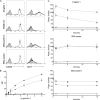
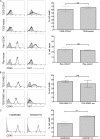
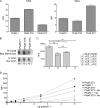
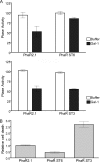
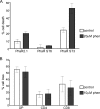
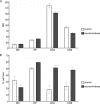
Similar articles
-
The ST6Gal I sialyltransferase selectively modifies N-glycans on CD45 to negatively regulate galectin-1-induced CD45 clustering, phosphatase modulation, and T cell death.J Biol Chem. 2003 Feb 28;278(9):7469-75. doi: 10.1074/jbc.M209595200. Epub 2002 Dec 23. J Biol Chem. 2003. PMID: 12499376
-
Galectin-1 binds different CD43 glycoforms to cluster CD43 and regulate T cell death.J Immunol. 2006 Oct 15;177(8):5328-36. doi: 10.4049/jimmunol.177.8.5328. J Immunol. 2006. PMID: 17015718
-
CD45 modulates galectin-1-induced T cell death: regulation by expression of core 2 O-glycans.J Immunol. 2001 Nov 15;167(10):5697-707. doi: 10.4049/jimmunol.167.10.5697. J Immunol. 2001. PMID: 11698442
-
T cells modulate glycans on CD43 and CD45 during development and activation, signal regulation, and survival.Ann N Y Acad Sci. 2012 Apr;1253:58-67. doi: 10.1111/j.1749-6632.2011.06304.x. Epub 2012 Jan 30. Ann N Y Acad Sci. 2012. PMID: 22288421 Free PMC article. Review.
-
A cell death pathway induced by antibody-mediated cross-linking of CD45 on lymphocytes.Crit Rev Immunol. 2003;23(5-6):421-40. doi: 10.1615/critrevimmunol.v23.i56.40. Crit Rev Immunol. 2003. PMID: 15030310 Review.
Cited by
-
Loss of effector function of human cytolytic T lymphocytes is accompanied by major alterations in N- and O-glycosylation.J Biol Chem. 2012 Mar 30;287(14):11240-51. doi: 10.1074/jbc.M111.320820. Epub 2012 Feb 13. J Biol Chem. 2012. PMID: 22334653 Free PMC article.
-
A novel lectin from Artocarpus lingnanensis induces proliferation and Th1/Th2 cytokine secretion through CD45 signaling pathway in human T lymphocytes.J Nat Med. 2017 Apr;71(2):409-421. doi: 10.1007/s11418-017-1073-x. Epub 2017 Jan 21. J Nat Med. 2017. PMID: 28110389
-
Intracellular immune sensing promotes inflammation via gasdermin D-driven release of a lectin alarmin.Nat Immunol. 2021 Feb;22(2):154-165. doi: 10.1038/s41590-020-00844-7. Epub 2021 Jan 4. Nat Immunol. 2021. PMID: 33398185 Free PMC article.
-
Photogenerated lectin sensors produced by thiol-ene/yne photo-click chemistry in aqueous solution.Biosens Bioelectron. 2012 Apr 15;34(1):51-6. doi: 10.1016/j.bios.2012.01.001. Epub 2012 Jan 28. Biosens Bioelectron. 2012. PMID: 22341757 Free PMC article.
-
Galectin-1-mediated cell adhesion, invasion and cell death in human anaplastic large cell lymphoma: regulatory roles of cell surface glycans.Int J Oncol. 2014 May;44(5):1433-42. doi: 10.3892/ijo.2014.2319. Epub 2014 Mar 4. Int J Oncol. 2014. PMID: 24589677 Free PMC article.
References
-
- Hogquist K. A., Baldwin T. A., Jameson S. C. (2005) Nat. Rev. Immunol. 5, 772–782 - PubMed
-
- Liu S. D., Tomassian T., Bruhn K. W., Miller J. F., Poirier F., Miceli M. C. (2009) J. Immunol. 182, 5283–5295 - PubMed
-
- Perillo N. L., Pace K. E., Seilhamer J. J., Baum L. G. (1995) Nature 378, 736–739 - PubMed
Publication types
MeSH terms
Substances
Grants and funding
LinkOut - more resources
Full Text Sources
Molecular Biology Databases
Research Materials
Miscellaneous

